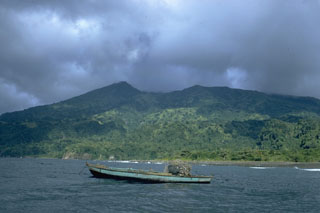Report on Soufriere St. Vincent (Saint Vincent and the Grenadines) — November 1979
Scientific Event Alert Network Bulletin, vol. 4, no. 11 (November 1979)
Managing Editor: David Squires.
Soufriere St. Vincent (Saint Vincent and the Grenadines) Lava extrusion stopped
Please cite this report as:
Global Volcanism Program, 1979. Report on Soufriere St. Vincent (Saint Vincent and the Grenadines) (Squires, D., ed.). Scientific Event Alert Network Bulletin, 4:11. Smithsonian Institution. https://doi.org/10.5479/si.GVP.SEAN197911-360150
Soufriere St. Vincent
Saint Vincent and the Grenadines
13.33°N, 61.18°W; summit elev. 1220 m
All times are local (unless otherwise noted)
No lava has been extruded into Soufrière's central crater since the survey of 25 October. However, monitoring of the volcano by the Seismic Research Unit, University of the West Indies, continues. Data from four seismometers are telemetered continuously to Trinidad, and scientists visit the volcano every weekend.
Further References. Fiske, R., and Sigurdsson, H. (eds)., 1982, Soufrière Volcano, St. Vincent: Observations of its 1979 eruption from the ground, aircraft, and satellites: Science, v. 216, no. 4550, p. 1105-1126 (11 papers).
Shepherd, J.B., Aspinall, W.P., Rowley, K.C., and others, 1979, The eruption of Soufrière Volcano, St. Vincent April-June 1979: Nature, v. 282, p. 24-28.
Shepherd, J.B., and Sigurdsson, H., 1982, Mechanism of the 1979 Explosive Eruption of Soufrière Volcano, St. Vincent: JVGR, v. 13, p. 119-130.
Sparks, R.S.J., and Wilson, L., 1982, Explosive volcanic eruptions - V. Observations of plume dynamics during the Soufrière eruption, St. Vincent: Geophysical Journal of the Royal Astronomical Society, v. 69, p. 551-570.
Geological Summary. Soufrière St. Vincent is the northernmost and youngest volcano on St. Vincent Island. The NE rim of the 1.6-km wide summit crater is cut by a crater formed in 1812. The crater itself lies on the SW margin of a larger 2.2-km-wide caldera, which is breached widely to the SW as a result of slope failure. Frequent explosive eruptions after about 4,300 years ago produced pyroclastic deposits of the Yellow Tephra Formation, which cover much of the island. The first historical eruption took place in 1718; it and the 1812 eruption produced major explosions. Much of the northern end of the island was devastated by a major eruption in 1902 that coincided with the catastrophic Mont Pelée eruption on Martinique. A lava dome was emplaced in the summit crater in 1971 during a strictly effusive eruption, forming an island within a lake that filled the crater. A series of explosive eruptions in 1979 destroyed the 1971 dome and ejected the lake; a new dome was then built.
Information Contacts: J. Tomblin, UWI.

